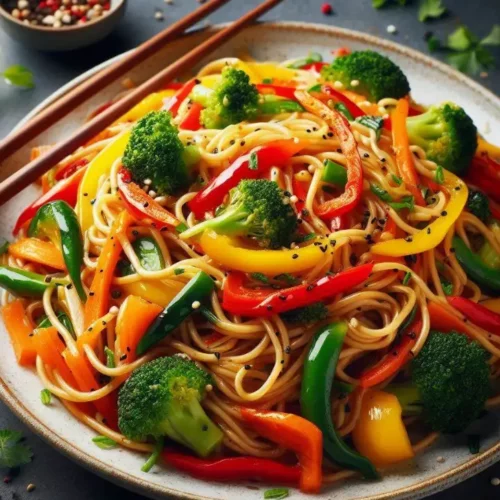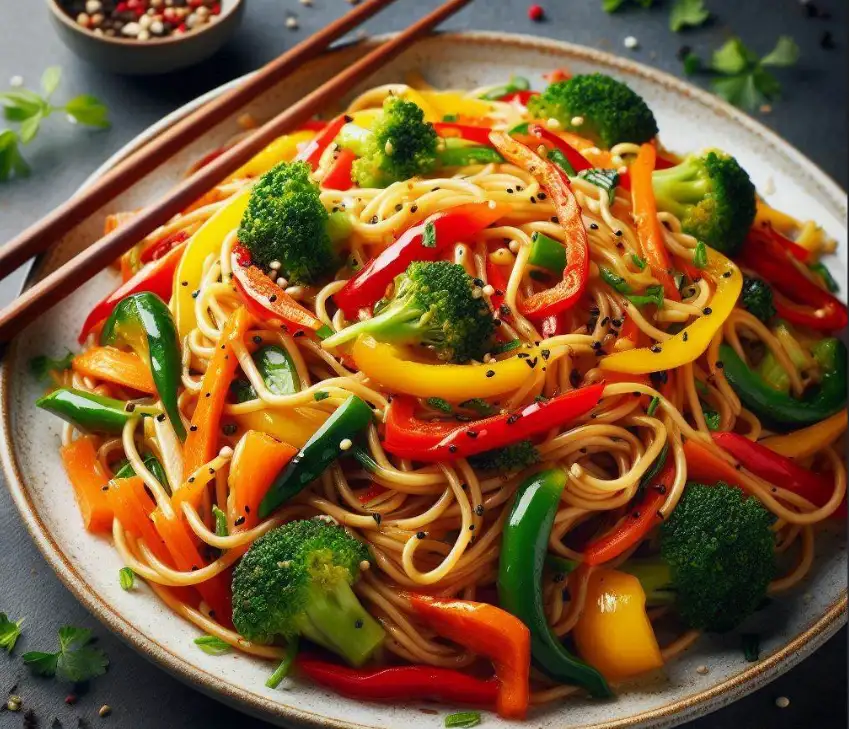Tallarin Saltado, a beloved Peruvian stir-fried noodle dish, offers the delightful feature of combining Chinese stir-fry techniques with Peruvian ingredients. This advantage brings together the smoky, rich flavors of wok-cooking with the vibrant and diverse tastes of Peru, resulting in a uniquely satisfying and flavorful experience that celebrates cultural fusion and culinary creativity.
What Is Tallarin Saltado?
Tallarin Saltado, or Peruvian stir-fried noodles, is a versatile dish typically made with spaghetti or linguine, proteins like chicken, beef, or pork, and a colorful array of vegetables. These ingredients are stir-fried in a savory sauce made from soy sauce, oyster sauce, and vinegar, often accented with the spicy and fruity flavor of aji amarillo, a Peruvian chili pepper.

How to Make Tallarin Saltado
Ingredients
- Noodles: 1 pound of spaghetti or linguine
- Protein: 1 pound of chicken thighs beef strips, pork cubes, or tofu (for a vegetarian option)
- Vegetables: 1 red onion sliced, 1 red bell pepper (sliced), 2 cups cabbage (chopped), 3 cups spinach, and optional snow peas
- Seasoning: 4 tablespoons soy sauce 3 tablespoons oyster sauce, 1 tablespoon sesame oil, 1 tablespoon red wine or balsamic vinegar
- Spices: 3 garlic cloves minced, 1 tablespoon ginger (grated), and 1 teaspoon aji amarillo paste (adjust for heat preference)
- Oil: 4 tablespoons avocado or vegetable oil
- Garnish: Green onions sesame seeds, and lime wedges
Instructions
- Prepare the Noodles:
- Boil the noodles in salted water until al dente. Reserve 1/2 cup of pasta water, then drain and rinse the noodles with cool water to stop the cooking process.
- Cook the Protein:
- Season your protein with salt and pepper. Heat 2 tablespoons of oil in a large wok or skillet over medium-high heat. Stir-fry the protein until cooked through and lightly browned. Remove and set aside.
- Stir-Fry Vegetables:
- In the same pan, add the remaining oil. Stir-fry the garlic, ginger, and onions for 2-3 minutes. Add the aji amarillo paste and cook until fragrant. Then, toss in the bell pepper, cabbage, and spinach, cooking for another 3-4 minutes.
- Combine Ingredients:
- Return the protein to the pan. Add the noodles and reserved pasta water. Pour in the soy sauce, oyster sauce, sesame oil, and vinegar. Toss everything together until well combined and heated through.
- Serve:
- Transfer to a serving dish. Garnish with green onions, sesame seeds, and lime wedges.
Cultural Significance of Tallarin Saltado
The dish reflects the cultural and culinary exchange between China and Peru. As one of the most popular chifa dishes, Tallarin Saltado is a staple in Peruvian households and a favorite in Peruvian-Chinese restaurants. Its adaptability allows cooks to incorporate local ingredients, making it a canvas for culinary creativity.
Common Variations
- Vegetarian Tallarin Saltado: Substitute protein with tofu or additional vegetables like zucchini or mushrooms.
- Spicy Version: Increase the amount of aji amarillo or add sliced jalapeños for extra heat.
- Seafood Twist: Use shrimp or calamari for a coastal flavor.
Tips for Perfecting Tallarin Saltado
- Create a Fond: Let the protein develop a good sear before stirring. This adds depth to the sauce.
- Customize Vegetables: Use what you have on hand, such as broccoli, carrots, or bok choy.
- Balance the Sauce: Adjust soy sauce and vinegar to match your taste preference, especially if you prefer a less salty or tangy flavor.
Pairing Suggestions
Serve Tallarin Saltado with a side of roasted vegetables or a refreshing salad. For beverages, a glass of chicha morada, a traditional Peruvian purple corn drink, complements the dish beautifully.
Conclusion
Tallarin Saltado is more than just a dish; it’s a testament to Peru’s rich culinary history and its openness to cultural fusion. Whether you stick to the traditional recipe or add your personal twist, Tallarin Saltado promises a flavorful journey that delights the palate and warms the soul.

